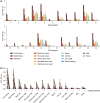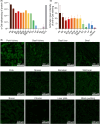Allergenic potency of various foods of mammalian origin in patients with α-Gal syndrome
- PMID: 39007417
- PMCID: PMC11724243
- DOI: 10.1111/all.16235
Allergenic potency of various foods of mammalian origin in patients with α-Gal syndrome
Abstract
Background: The α-Gal syndrome (AGS) is an emerging allergy to mammalian food caused by IgE-mediated reactions to the carbohydrate galactose-α-1,3-galactose (α-Gal). Mammalian food sources contain α-Gal, but the amount differs. The objective of this study was to investigate the allergenic potency of various foods of mammalian origin among AGS patients.
Methods: Twenty-six AGS patients were included. Food extracts from innards, lean meats, processed meat products, milk, and whey were analyzed. Immunoblot, ELISA, immunofluorescence, and basophil activation test were used to determine the α-Gal content, characterize IgE binding, and assess foods' allergenicity.
Results: The determined amount of α-Gal, IgE reactivity to food extracts, and food extract potencies to activate patients' basophils correlated well with each other. Pork and beef kidney showed the highest allergenicity. Beef liver and bacon showed allergenicity comparable to that of lean meats. Game meat seemed to have a higher allergenic potency than meats from farm-raised animals. The processed meat products liver pâté and black pudding, despite lower α-Gal content, demonstrated moderate allergenicity. Milk showed the lowest allergenicity. IgE reactivity to food extracts was highly similar for all patients and strongly dominated by the α-Gal epitope.
Conclusions: The allergenic potency of mammalian meat depends on the origin of the meat, the different cuts, and type of processing, with innards posing the greatest risk to AGS patients. Even processed mammalian meat constitutes a risk. Dairy products show the lowest risk. This study highlights the importance of analyzing even more foods to improve the management of AGS.
Keywords: allergenic potency; basophil activation; milk; pork kidney; α‐Gal syndrome.
© 2024 The Author(s). Allergy published by European Academy of Allergy and Clinical Immunology and John Wiley & Sons Ltd.
Conflict of interest statement
MvH has received lecture fees from Thermo Fisher Scientific and Astra Zeneca outside the submitted work. The rest of the authors report no conflict of interest.
Figures





Similar articles
-
Two galactose-α-1,3-galactose carrying peptidases from pork kidney mediate anaphylactogenic responses in delayed meat allergy.Allergy. 2016 May;71(5):711-9. doi: 10.1111/all.12835. Epub 2016 Jan 27. Allergy. 2016. PMID: 26728983
-
Immunoproteomics of processed beef proteins reveal novel galactose-α-1,3-galactose-containing allergens.Allergy. 2014 Oct;69(10):1308-15. doi: 10.1111/all.12462. Epub 2014 Jul 28. Allergy. 2014. PMID: 24942937
-
Meat allergy associated with galactosyl-α-(1,3)-galactose (α-Gal)-Closing diagnostic gaps by anti-α-Gal IgE immune profiling.Allergy. 2018 Jan;73(1):93-105. doi: 10.1111/all.13238. Epub 2017 Aug 15. Allergy. 2018. PMID: 28670695 Free PMC article.
-
Environmental and Molecular Drivers of the α-Gal Syndrome.Front Immunol. 2019 May 31;10:1210. doi: 10.3389/fimmu.2019.01210. eCollection 2019. Front Immunol. 2019. PMID: 31214181 Free PMC article. Review.
-
[Diagnostics of alpha-gal syndrome : Current standards, pitfalls and perspectives].Hautarzt. 2019 Jan;70(1):36-43. doi: 10.1007/s00105-018-4288-1. Hautarzt. 2019. PMID: 30617520 Review. German.
Cited by
-
Allergic reactions associated with tsetse fly bites.Ann Med. 2025 Dec;57(1):2514096. doi: 10.1080/07853890.2025.2514096. Epub 2025 Jun 8. Ann Med. 2025. PMID: 40485140 Free PMC article.
References
-
- Hamsten C, Starkhammar M, Tran TA, et al. Identification of galactose‐alpha‐1,3‐galactose in the gastrointestinal tract of the tick Ixodes ricinus; possible relationship with red meat allergy. Allergy. 2013;68(4):549‐552. - PubMed
MeSH terms
Substances
Supplementary concepts
Grants and funding
LinkOut - more resources
Full Text Sources
Medical

